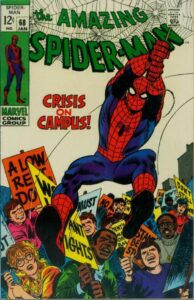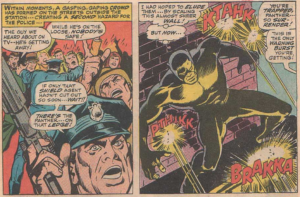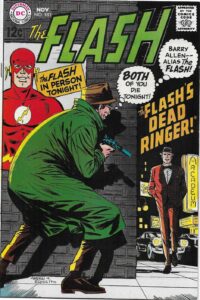1968 was a great year for comics, especially if you were a Marvel Comics fan. Incredible Hulk and Captain America got their own titles from previous titles. Iron Man and Silver Surfer received their own titles with epic 1st issue art by Gene Colan and John Buscema respectively. Steranko’s art in Nick Fury, Agent of Shield is legendary because it was groundbreaking. His graphic design background was evident on all of the psychedelic covers he created.
At DC, 1968 was a year of change as they added some incredible talent to their roster. Steve Ditko started work on Beware the Creeper and Hawk and Dove first in Showcase and then in their own titles. Honestly, DC hit the jackpot with writers and artists, Jim Shooter, Joe Orlando, Joe Kubert, Denny O’Neil, and Dick Giordano.
In the United States, 1968 was tumultuous for several reasons, including assassinations, war protests, violence, and intense police clashes. Most comics from that year are the typical superhero storyline with a clear good guy and bad guy. There were some issues that delved into the culture of the day either through art or story, here are the ones I found.
 The Amazing Spider-Man #65 (October 1968): This cover depicts Spider-Man being attacked by a group of police officers. This cover was created by John Romita Sr. and reflects the real-world tensions between law enforcement and protestors/minorities in 1968.
The Amazing Spider-Man #65 (October 1968): This cover depicts Spider-Man being attacked by a group of police officers. This cover was created by John Romita Sr. and reflects the real-world tensions between law enforcement and protestors/minorities in 1968.
The Amazing Spider-Man #68 and #69 (January/February 1969): Issue 68 depicts Spider-Man swinging over angry protesters. The cover was also created by John Romita Sr. and was inspired by the real-world protests that were taking place in the United States at the time, such as the Civil Rights Movement and the Vietnam War protests. Within the story, there were college protests and police station protests that erupt into violence. One scene shows police opening fire on an unarmed Spider-man.
The Amazing Spider-Man #70 (March 1969): The John Romita Sr. cover shows Spider-Man in a searchlight with a group of police officers taking aim at him. Once again Spider-man is shot at by police multiple times when he is obviously unarmed unless you count web slingers. This book was on newsstands in December 1968 and was written by Stan Lee.
 Avengers #52 (May 1968): It’s not the cover of this one that shows skirmishes with police, it’s the interior. The Grim Reaper frames Black Panther for murder and he is taken into police custody. When the Black Panther escapes the precinct, the police open fire on him on three separate occasions. He is unarmed on two occasions and has a sword during the last shooting. This story was written by Roy Thomas and hit newsstands in March of 1968, Martin Luther King Jr. would be assassinated less than a month later.
Avengers #52 (May 1968): It’s not the cover of this one that shows skirmishes with police, it’s the interior. The Grim Reaper frames Black Panther for murder and he is taken into police custody. When the Black Panther escapes the precinct, the police open fire on him on three separate occasions. He is unarmed on two occasions and has a sword during the last shooting. This story was written by Roy Thomas and hit newsstands in March of 1968, Martin Luther King Jr. would be assassinated less than a month later.
Quick side note: Marvel changed Black Panther’s name for a while to avoid confusion with the Black Panthers.
Batman #201 (May 1968): This Irv Novick cover shows Batman surrounded by armed police officers. They are actually hired guns impersonating police officers so this one misses the full cultural significance.
Batman #206 (November 1968): This is a powerful cover that shows Batman being led to the electric chair by a police officer and a priest. Once again this isn’t what it looks like, it’s actually someone whose last request was to be electrocuted as Batman. Yes, that’s a little sick.
 Flash #183 (November 1968): In April Martin Luther King Jr. was assassinated and Robert Kennedy was assassinated in June 1968. In September this Ross Andru cover was released showing someone waiting to assassinate the Flash.
Flash #183 (November 1968): In April Martin Luther King Jr. was assassinated and Robert Kennedy was assassinated in June 1968. In September this Ross Andru cover was released showing someone waiting to assassinate the Flash.
Hawk and the Dove (starting September 1968): This entire series is about an aggressive and passive brother. Dove (Don Hall) is constantly striving for non-violence while Hawk (Hank Hall) is looking to fight. Issue 3 is especially poignant as Dove tries to stop a policeman from shooting a cat burglar only to get him shot by police. Issue 3 was released in October 1968 two months after the antiwar demonstrators and police clashed in Chicago at the Democratic National Convention.
These stories and covers are a testament to the power of comic books to reflect the social and political climate of their time. If you were a child in the late 1960’s you probably didn’t pick up the social relevance found in these issues but it’s obvious looking back. What do you think about these issues?
by Ron Cloer
I have strived to be unbiased and only report the details of the stories or covers without political commentary.
Source: Comics Price Guide

